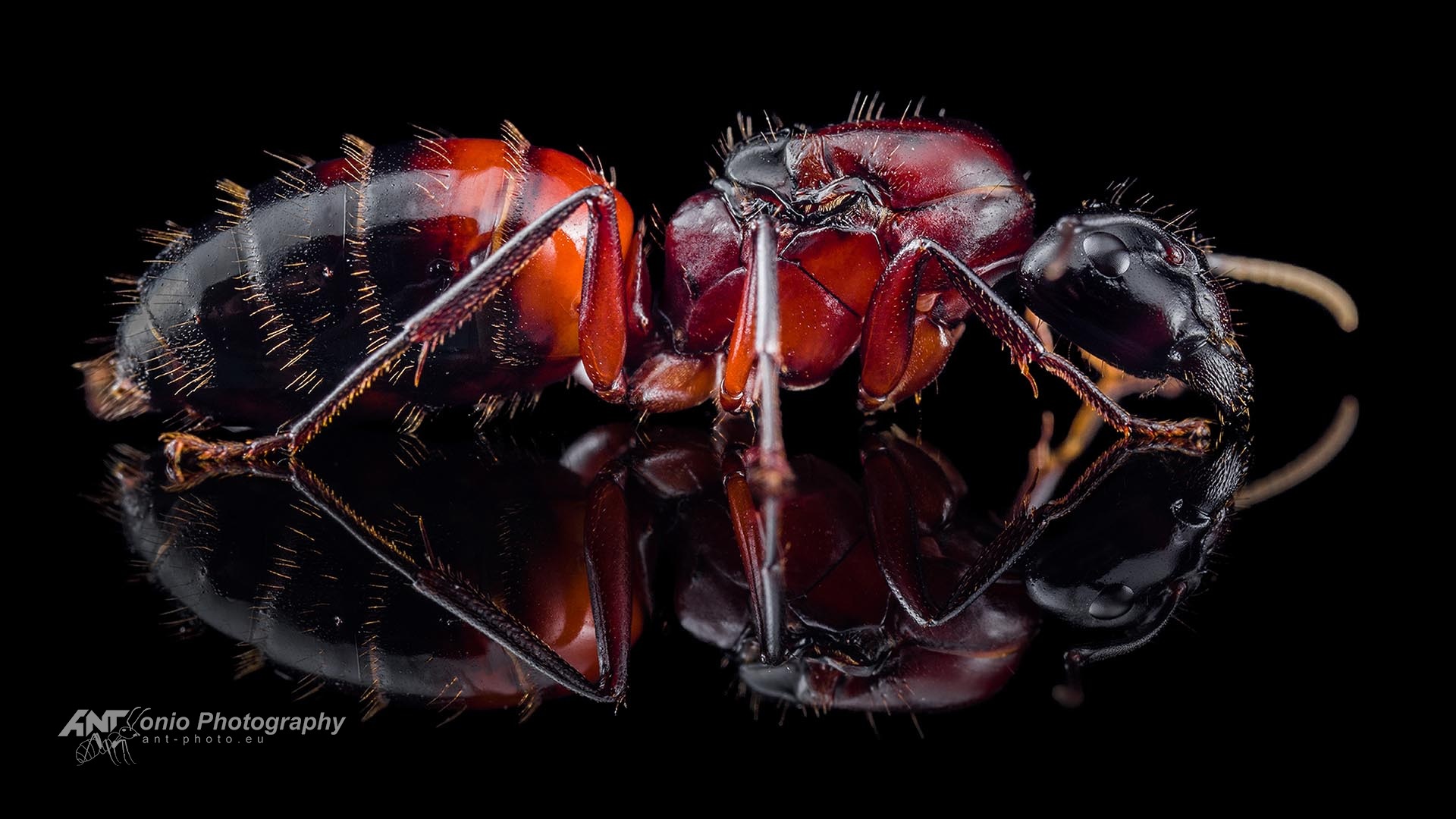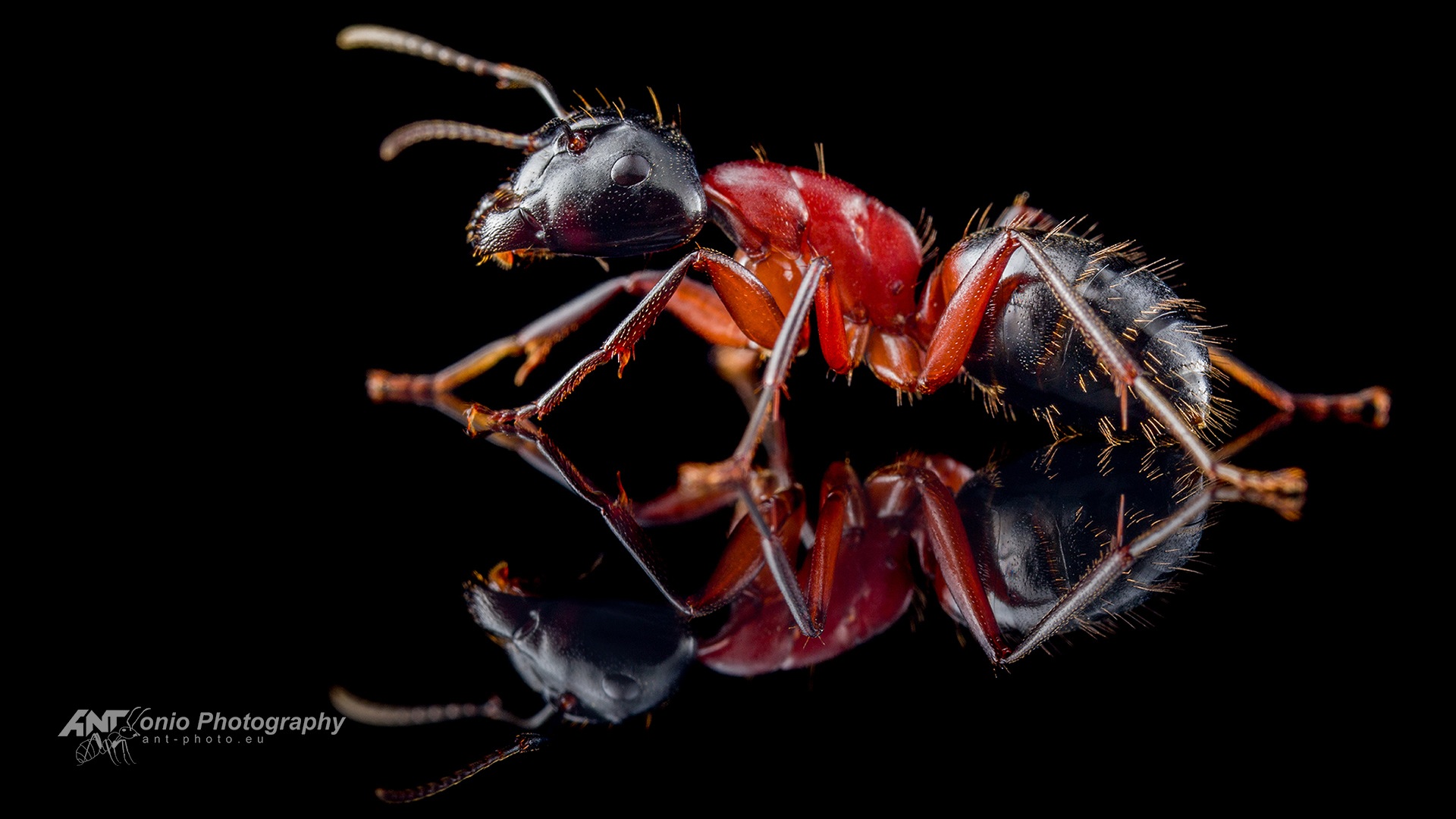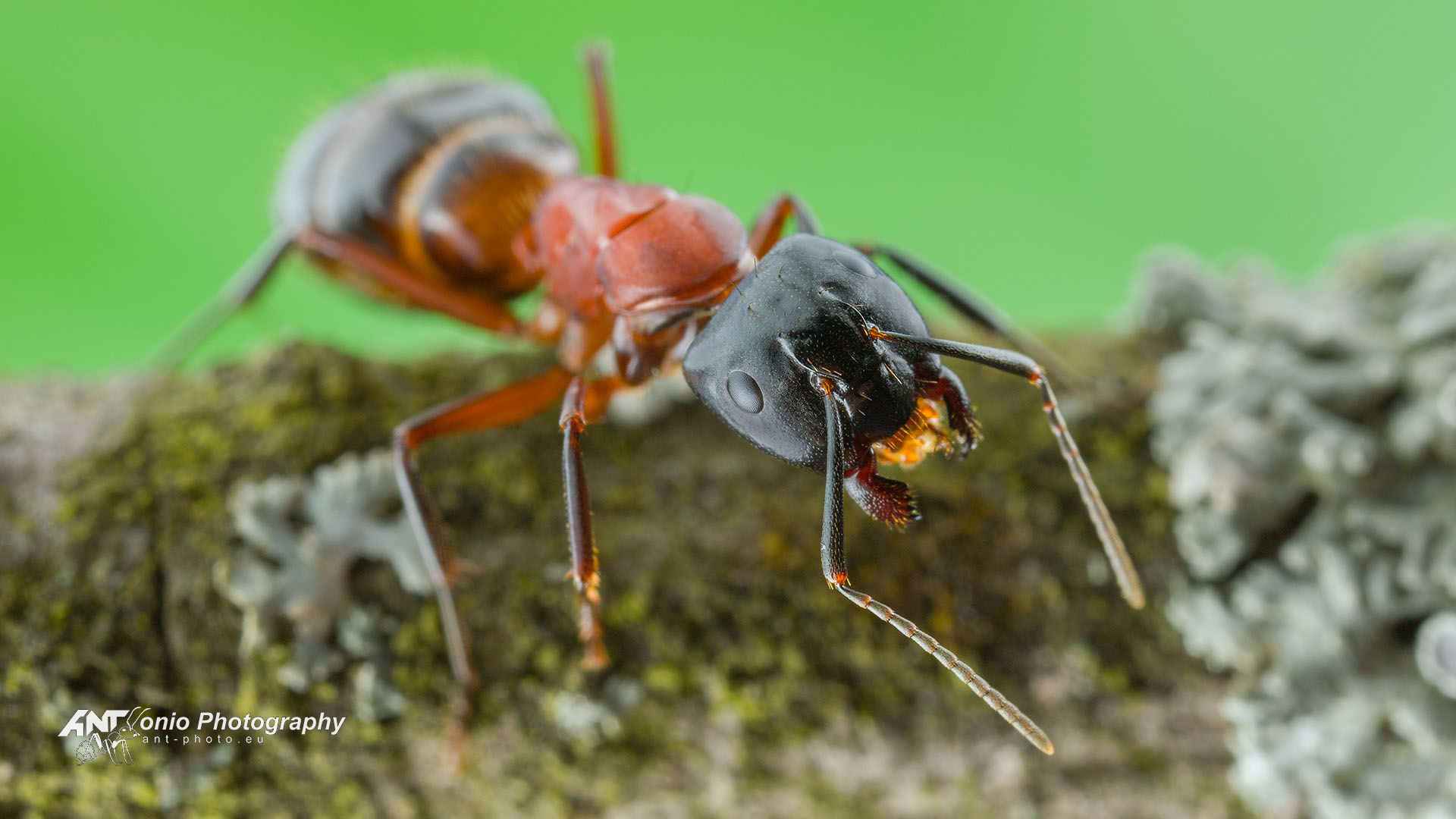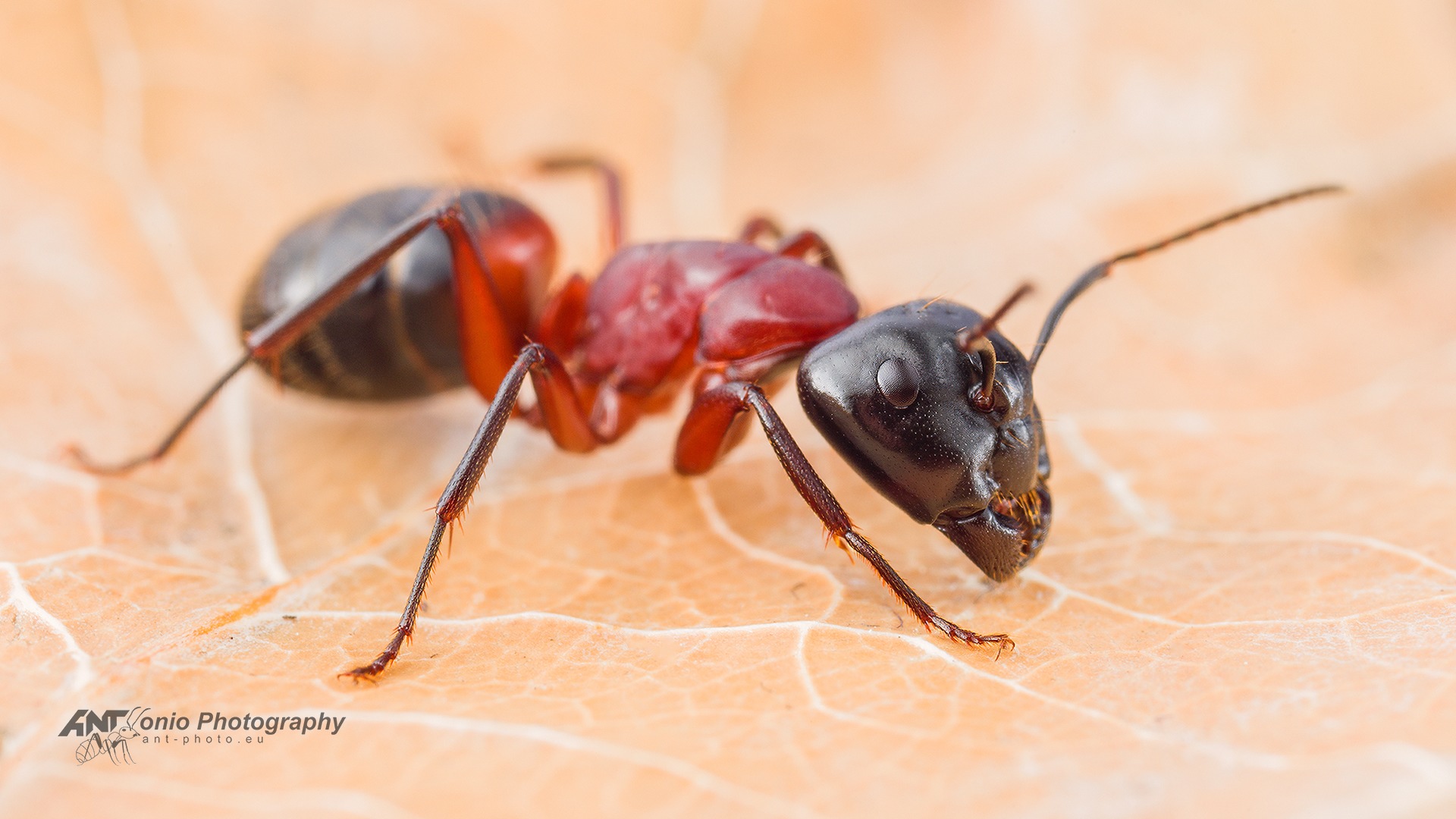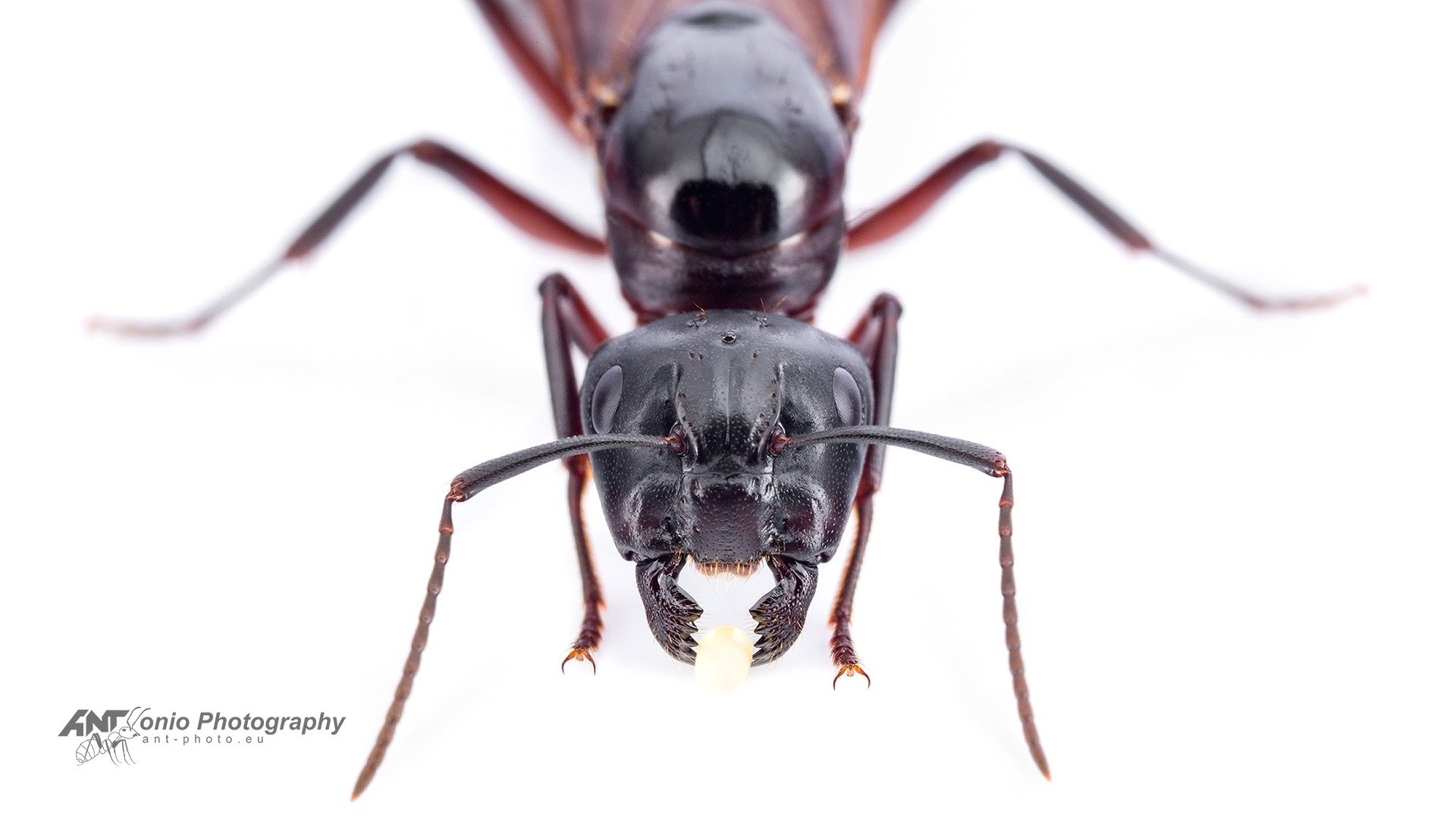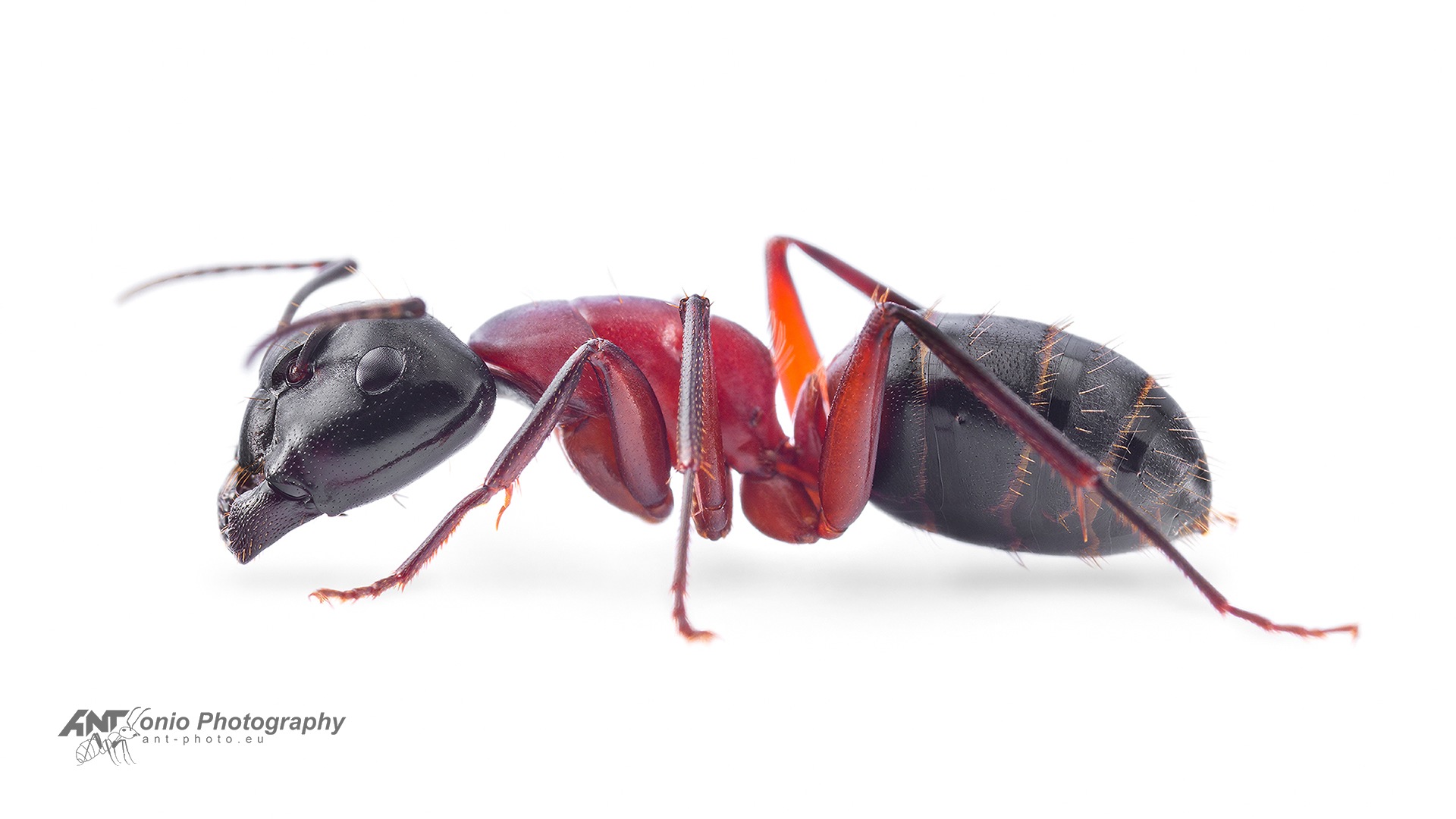Camponotus ligniperda
Brown-black Carpenter Ant
Gmachówka drzewotoczna
| Rodzina | Family: | Formicidae |
| Podrodzina | Subfamily: | Formicinae |
| Plemię | Tribe: | Camponotini |
| Rodzaj | Genus: | Camponotus |
| Gatunek | Species: | C. ligniperda |
Camponotus ligniperda photo gallery
Opis Camponotus ligniperda
1. Wstęp
Camponotus ligniperda (Latreille, 1802) czyli gmachówka drzewotoczna to gatunek dużej mrówki z podrodzaju Camponotus s. str.. Królowe tych gmachówek to największe mrówki jakie możemy spotkać w Europie. Z uwagi na wielkość oraz bardzo ładne ubarwienie, mrówki te spotyka się bardzo często w hodowlach i często wybierane są na pierwszą mrówkę w hodowli.
2. Występowanie
Camponotus ligniperda występuje w: Albanii, Andorze, Francji Niemczech, Liechtensteinie, Norwegii, Ukrainie, Turcji, Szwajcarii, Szwecji, Hiszpanii, Słowenii, Słowacji, Rosji, Rumunii, Mołdawii, Macedonii Północnej, Polsce, Holandii, Czarnogórze, Luksemburgu, Litwie, Łotwie, Grecji i na półwyspie iberyjskim. Zamieszkuje słoneczne lasy liściaste i mieszane, oraz murawy kserotermiczne (Rarchenko i in., 2004; Seifert, 2018)
3. Budowa gniazda
Gniazda tych mrówek są zbudowane zazwyczaj z części w martwym lub żywym pniu oraz dużej części podziemnej. Na terenach bez drzew mrowiska są całkowicie podziemne. C. ligniperda preferują drewno iglaste, ale są w stanie przegryźć się nawet przez dąb, u którego odległość między słojami wynosić może zaledwie 0.5mm. (Seifert, 2018)
4. Wygląd
Camponotus ligniperda to największy gatunek mrówki w Europie. Królowe mierzą ok. 18mm. Dla porównania, królowe jednych z najmniejszych polskich mrówek, Tetramorium atratulum (Schenck, 1852), mierzą nawet poniżej 3mm. Królowe europejskiego gatunku inkwilinistycznego pasożyta (tego typu pasożyty są całkowicie uzależnione od gospodarza, znanym powszechnie przykładem jest Strongylognathus testaceus (Schenck, 1852)), Plagiolepis xene (Stärcke, 1936), mierzą zaledwie ok. 1,5mm. Robotnice C. ligniperda są polimorficzne, standardowo mają jaśniejszą mesosomę od C. herculeanus (Linnaeus, 1758), oraz większą czerwoną plamkę na pierwszym tergicie gastra (Seifert, 2019).
5. Struktura kolonii
Kolonie C. ligniperda mogą być monoginiczne lub oligoginiczne, czyli w gnieździe występuje jedna lub kilka nietolerujących się królowych. Zjawisko to występuje także u Camponotus nicobarensis (Mayr, 1865), azjatyckiego gatunku Camponotus. Do powstawania gniazd oligoginicznych może dojść za sprawą przyjęcia królowych przez osieroconą kolonię, przyjęcia królowej w peryferyjnej części gniazda lub przez zamianę starej matki na nową.
Pleometrozja, czyli zjawisko powszechne u np. Lasius flavus (Fabricius, 1782), polegające na zakładaniu kolonii przez kilka królowych było obserwowane u C. ligniperda bardzo rzadko i zawsze kończyło się zabiciem lub wypędzeniem wszystkich królowych oprócz tej najsilniejszej (Gadau i in., 1998). Kolonia zakładana jest sposobem klasztornym, co oznacza, że królowa nie pobiera pokarmu aż do odchowania pierwszych robotnic, co zazwyczaj udaje się dopiero po zimie (Eidmann, 1926). Loty godowe tych mrówek przypadają na wiosnę, więc matka założycielka może nie pobierać pokarmu z zewnątrz przez prawie rok (Seifert, 2018).
6. Odżywianie
Camponotus ligniperda odżywiają się spadzią mszyc, które są hodowane i strzeżone przez robotnice. Potrafią napadać na orszaki Formica sanguinea (Latreille, 1798) transportujące ukradzione potomstwo, które dla gmachówek może posłużyć jako źródło białka. Zaobserwowano nacinanie kory drzew w celu pozyskania soków roślinnych (Seifert, 2018). W szczególnych przypadkach C. ligniperda mogą żerować prawie wyłącznie na innych mrówkach (Czechowski & Pisarski, 1988).
7. Behawior
Alarm C. ligniperda, wywoływany przez stukanie gastrami robotnic o podłoże jest łatwo słyszalny dla ludzkiego ucha. Mrówki te nie są terytorialne, ale bronią źródeł pożywienia i gniazda. Robotnice major odgrywają ważną rolę podczas jego obrony. Walczą z czułkami wysuniętymi do tyłu, napierając głową i siekając przeciwników żuwaczkami. Major C. ligniperda może zabić 3 robotnice Formica w 15sekund (Seifert 2018).
Mimo sowich rozmiarów często ulegają mniejszym mrówkom. Zaobserwowano sytuację, gdzie za robotnicą C. ligniperda, która niosła zdobycz, podążała robotnicą Lasius niger (Linnaeus, 1758). Gdy gmachówka odłożyła ładunek, aby wyczyścić czułki, mniejsza od niej hurtnica zabierała jej zdobycz spod żuwaczek i uciekała. Współpraca między osobnikami C. ligniperda jest na niskim poziomie. Podczas walki nie pomagają swoim siostrom będącym w niebezpieczeństwie (Czechowski & Pisarski, 1988).
8. Interakcje z człowiekiem
Mrówki gmachówki potrafią uprzykrzyć ludziom życie. Mogą niszczyć izolację budynków mieszkalnych lub osłabiać konstrukcje nośne (Mallis i Hedges, 1997). W stanie Waszyngton w USA koszty ich zwalczania w 1980 roku wyniosły 25 milionów dolarów (Aak i in. 2013). Także mogą wyrządzać szkody na plantacjach dębu przez nacinanie młodych sadzonek (Prell, 1926).
9. Hybrydyzacja
Hybrydyzacja wśród środkowoeuropejskich mrówek została stwierdzona do marca 2019 roku u 34 gatunków, w 25 różnych kombinacjach, w sześciu rodzajach (Pearson 1983; Seifert 1984; Fischer 1987: Douwes & Stille 1991; Seifert 1991; Seifert 1999; Seifert & Goropashnaya 2004; Pusch i in. 2006; Seifert 2006; Kulmuni i in. 2010; Bernasconi i in. 2010; Seifert i in. 2010; Steiner i in. 2010; Van der Have i in. 2011; Bagherian i in. 2012; Seifert 2013: Purcell i in. 2016). Jedną ze stwierdzonych hybryd były Camponotus herculeanus × ligniperda . Na terenach, gdzie występują oba gatunki współczynnik hybrydyzacji zdaje się nie przekraczać 1% (Seifert, 2019).
Description of Camponotus ligniperda
1. Introduction
Camponotus ligniperda (Latreille, 1802), also known as the brown-black carpenter ant, is a species of large ant from the subgenus Camponotus s. str.. The queens of these carpenter ants are the largest ants that can be found in Europe. Due to their size and very attractive coloration, these ants are very often encountered in ant-keeping and are frequently chosen as the first ant species for beginners in the hobby.
2. Distribution
3. Construction of the nest
4. Appearance
5. Colony structure
6. Nutrition
7. Behavior
8. Interactions with humans
Carpenter ants can make life difficult for humans. They can damage the insulation of residential buildings or weaken load-bearing structures (Mallis and Hedges, 1997). In the state of Washington, USA, the costs of controlling them in 1980 amounted to 25 million dollars (Aak et al., 2013). They can also cause damage to oak plantations by cutting young seedlings (Prell, 1926).
9. Hybridization
Hybridization among Central European ants was documented until March 2019 in 34 species, in 25 different combinations, across six genera (Pearson 1983; Seifert 1984; Fischer 1987; Douwes & Stille 1991; Seifert 1991; Seifert 1999; Seifert & Goropashnaya 2004; Pusch et al. 2006; Seifert 2006; Kulmuni et al. 2010; Bernasconi et al. 2010; Seifert et al. 2010; Steiner et al. 2010; Van der Have et al. 2011; Bagherian et al. 2012; Seifert 2013; Purcell et al. 2016). One of the identified hybrids was Camponotus herculeanus × ligniperda. In areas where both species occur, the hybridization rate seems not to exceed 1% (Seifert, 2019).
Bibliografia / References
- AAK A, BIRKEMOE T, LINDSTEDT HH, EDGAR KS. 2013. Excavation of building insulation by carpenter ants (Camponotus ligniperda, Hymenoptera; Formicidae). Int. Pest Contr. 55(3):140-148.
- Bagherian A, Münch W, Seifert B (2012) A first demonstration of interspecific hybridization in Myrmica ants by geometric morphometrics (Hymenoptera: Formicidae). Myrmecol News 17:121–131.
- Bernasconi C, Cherix D, Seifert B, Pamilo P (2010) Molecular taxonomy of the Formica rufa group (red wood ants) (Hymenoptera: Formicidae): a new cryptic species in the Swiss. Alps? Myrmecol News 14:37–47.
- Czechowski, W., and Pisarski, B. (1988). Inter- and intraspecific competitive relations inCamponotus ligniperdus (Latr.) (Hymenoptera, Formicidae).Ann Zool. 41: 355–381.
- Douwes P, Stille B (1991) Hybridization and variation in the Leptothorax tuberum group (Hymenoptera: Formicidae). Z Zool Syst Evol 29:165–175.
- Eidmann H 1926: Die Koloniegründung der einheimi- schen Ameisenarten. – Zeitschrift für vergleichende Physiologie 3: 776-826.
- Fischer K (1987) Karyotypuntersuchungen an selbständigen und sozialparasitischen Arten der Tribus Leptothoracini (Hymenoptera, Formicidae) im Hinblick auf ihre Verwandtschaftsbeziehungen. PhD thesis, Technische Hochschule Darmstadt Gadau, J., Gertsch, P., Heinze, J. i in. Oligoginia niepowiązanych królowych mrówki cieśli Camponotus ligniperdus . Behav Ecol Sociobiol 44 , 23–33 (1998).
- Kulmuni J, Seifert B, Pamilo P (2010) Segregation distortion causes large-scale differences between male and female genomes in hybrid ants. PNAS 107(16):7371–7376.
- Mallis, A. & Hedges, S. A. (1997) Handbook of pest control: the behaviour, life history, and control of household pests, pp. 1-1456.
- Mallis Handbook & Technical Training Company, USA. Pearson B (1983) Hybridisation between Lasius niger and Lasius alienus. Insectes Soc 30:402–411.
- Prell H 1926: Das Rätsel des Eichentriebschnittes. Cam- ponotus herculeanus als Eichenfeind. – Tharandter Forst- liches Jahrbuch 76: 49-62.
- Purcell J, Zahnd S, Athanasiades A, Türler R, Chapuisat M, Brelsford A (2016) Ants exhibit asymmetric hybridization in a mosaic hybrid zone. Mol Ecol 25:4866–4874.
- Pusch K, Heinze J, Foitzik S (2006) The influence of hybridization on the colony structure in the ant species Temnothorax nylanderi and T. crassispinus. Insectes Soc 53:439–445.
- Radchenko,A. and Czechowska,W. and Czechowski,W., 20053039399, Polish, Bulletin, Poland, (No.169), Toruń, Klucze do Oznaczania Owadów Polski, (138 pp.), Polskie Towarzystwo Entomologiczne, Keys for identification of insects of Poland. Part XXIV – Hymenoptera. Notebook 63 – Ants – Formicidae.
- Seifert B (1984) Nachweis einer im Freiland aufgetretenen Bastardierung von Leptothorax nigriceps Mayr und Leptothorax unifasciatus (Latr.) mittels einer multiplen Diskriminanzanalyse. Abh Ber Naturkundemus Görlitz 58/7:1–8.
- Seifert B (1991) The phenotypes of the Formica rufa complex in East Germany. Abh Ber Naturkundemus Görlitz 65/1:1–27.
- Seifert B (1999) Interspecific hybridisations in natural populations of ants by example of a regional fauna (Hymenoptera:Formicidae). Insectes Soc 46:45–52.
- Seifert B (2006) Social cleptogamy in the ant subgenus Chthonolasius—survival as a minority. Abh Ber Naturkundemus Görlitz 77:251–276.
- Seifert B (2013) Keynote—frequency and evolutionary significance of hybridization in ants. In: Schlick-Steiner BC, Arthofer W, Steiner FM (eds): Abstract book of the 5th Central European workshop of myrmecology, p. 41 (published by CEWM 2013 organising committee, Innsbruck, Austria).
- Seifert B (2018) The ants of Central and North Europe. Lutra Verlags- und Vertriebsgesellschaft, Tauer Seifert, B. Hybridization in the European carpenter ants Camponotus herculeanus and C. ligniperda (Hymenoptera: Formicidae). Insect. Soc. 66, 365–374 (2019).
- Seifert B, Goropashnaya A (2004) Ideal phenotypes and mismatching haplotypes—errors of mtDNA treeing in ants (Hymenoptera: Formicidae) detected by standardized morphometry. Org Divers Evol 4/4:295–305.
- Seifert B, Kulmuni J, Pamilo P (2010) Independent hybrid populations of Formica polyctena × rufa wood ants (Hymenoptera: Formicidae) abound under conditions of forest fragmentation. Evol Ecol 24/5:1219–1237.
- Steiner FM, Seifert B, Moder K, Schlick-Steiner BC (2010) A multisource solution for a complex problem in biodiversity research: description of the cryptic ant species Tetramorium alpestre sp. n. (Hymenoptera: Formicidae). Zool Anz 24/9:223–254.
- Van der Have TM, Pedersen JS, Boomsma JJ (2011) Mating, hybridisation and introgression in Lasius ants (Hymenoptera: Formicidae). Myrmecol News 15:109–115.
- Czechowski W 1984: Tournaments and raids in Lasius niger (L) (Hymenoptera, Formicidae). – Annales Zoologici 38(2): 81-91.
- Glaser F 1998: Die Ameisenfauna des Arzler Kalvarienberges bei Innsbruck (Tirol, Österreich). – Berichte des Naturwissenschaftlich-Medizinischen Vereines in Innsbruck 85: 257-286.
- Pearson B 1983: Hybridisation between Lasius niger and Lasius alienus. – Insectes Sociaux 30: 402-411.
- Seifert B 1991: Lasius platythorax n. sp., a widespread sibling species of Lasius niger. – Entomologia Generalis 16(1): 69-81.
- Seifert B 2017: The ecology of Central European nonarboreal ants – 37 years of a broad-spectrum analysis under permanent taxonomic control. – Soil Organisms 89(1): 1-67.
- Seifert B (2018) The ants of Central and North Europe. Lutra Verlags- und Vertriebsgesellschaft, Tauer Van der Have TM, Pedersen JS, Boomsma JJ 2011: Mating, hybridisation and introgression in Lasius ants (Hymenoptera: Formicidae). – Myrmecological News 15: 109- 115.


